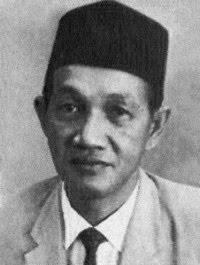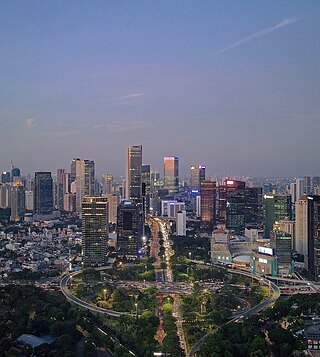
The rupiah is the official currency of Indonesia, issued and controlled by Bank Indonesia. Its name is derived from the Sanskrit word for silver, rupyakam (रूप्यकम्). Sometimes, Indonesians also informally use the word perak in referring to rupiah in coins. The rupiah is divided into 100 cents, although high inflation has rendered all coins and banknotes denominated in cents obsolete.
The boliviano is the currency of Bolivia. It is divided into 100 cents or centavos in Spanish. Boliviano was also the name of the currency of Bolivia between 1864 and 1963. From April 2018, the manager of the Central Bank of Bolivia, Pablo Ramos, announced the introduction of the new family of banknotes of the Plurinational State of Bolivia, started with the 10 Bs note, and then gradually arrived to introduce the 200 Bs note, presented in April 2019. The new family of banknotes of the Plurinational State received several awards such as "the best banknotes in Latin America", was highlighted by its security measures, its aesthetics and its inclusion of prominent figures in Bolivian history, being among those who awarded the "Latin American High Security Printing Press Conference".

Herman Johannes was an Indonesian professor, scientist, politician and National Hero. Johannes was the rector of Universitas Gadjah Mada in Yogyakarta (1961–1966), Coordinator for Higher Education from 1966 to 1979, a member of Indonesia's Presidential Supreme Advisory Council from 1968 to 1978, and the Minister for Public Works and Energy (1950–1951). He was also a member of the Executive Board of UNESCO from 1954 to 1957.

The first coins of the Indonesian rupiah were issued in 1951 and 1952, a year or so later than the first Indonesian rupiah banknotes printed, following the peace treaty with the Netherlands in November 1949. Although revolutionary currency had been issued by the provisional Indonesian government between 1945 and 1949, it had all been formed of paper, for metal were too scarce for the internationally isolated government to use as currency.

The first banknotes used in the archipelago that would become Indonesia were those issued by the United East India Company, credit letters of the rijksdaalder dating between 1783 and 1811. Netherlands Indies gulden government credit paper followed in 1815, and from 1827 to 1842 and again from 1866 to 1948 gulden notes of De Javasche Bank. Lower denominations were issued by the government in 1919–1920 and in 1939–1940 due to wartime metal shortages, but otherwise day-to-day transactions were conducted using coinage.

Cipto Mangunkusumo or Tjipto Mangoenkoesoemo was a prominent Indonesian independence leader and Sukarno's political mentor. Together with Ernest Douwes Dekker and Soewardi Soerjaningrat, he was one of the three founders of the influential Indische Party, a political party disseminating the idea of self-government of the Dutch East Indies. After the party was labeled subversive by the colonial court of law in 1913, he and his fellow IP leaders were exiled to the Netherlands.

The currency of Indonesia, the rupiah, has a long history dating back to its colonial period. Due to periods of economic uncertainty and high inflation, the currency has been re-valued several times.

Idham Chalid was an Indonesian politician, religious leader, and minister, who served as Chairman of the People's Consultative Assembly and Chairman of the People's Representative Council from 1972 until 1977. He was also a prominent leader of the Nahdlatul Ulama (NU) and leader of the United Development Party (PPP), from 1956 until 1984.

I Gusti Ketut Pudja was an Indonesian politician and national hero, who served as the first governor of Lesser Sunda from 1945 until 1946. He was a member of the Investigating Agency for Preparatory Work for Indonesian Independence (BPUPK). He was also present at Admiral Tadashi Maeda's house, during the preparation for the Proclamation of Indonesian Independence on 17 August 1945. Making him the only Balinese to be present during the proclamation.

The Indian 10-rupee coin is a denomination of the Indian rupee. The ₹10 coin is the second highest-denomination coin minted in India since its introduction in 2005. The present ₹10 coin in circulation is from the 2019 design. However, the previous ₹10 coins minted before 2019 are also legal tender in India. All ₹10 coins containing with and without the rupee currency sign are legal tender, as stated by the Reserve Bank of India. Along with the standard designs, there are 4 different designs for this denomination and this is used alongside the 10 rupee banknote.

Semanggi Interchange or commonly known as Semanggi Bridge is a major road interchange in Jakarta, Indonesia which consists of a cloverleaf interchange —the first, and until the 1990s the only, of its kind in Indonesia—and a partial turbine interchange. Two main roads of the city Gatot Subroto Road and Sudirman Road intersect at this interchange. Initially completed in 1962 as part of several projects intended to be completed before the 1962 Asian Games, the interchange is a landmark and an important part of the Golden Triangle of Jakarta.

The Jakarta Light Rapid Transit or Jakarta LRT is one of the light rapid transit systems in Jakarta, the capital city of Indonesia. It is conceived and built by the Jakarta provincial government. The first phase of the LRT, from Velodrome to Pegangsaan Dua, began commercial operations on 1 December 2019.
Super Air Jet is an Indonesian ultra low-cost airline based in Soekarno–Hatta International Airport. The airline was founded in March 2021 and commenced operations on 6 August 2021.

The Indonesian one thousand rupiah coin (Rp1,000) is a coin of the Indonesian rupiah. It circulates alongside the 1,000-rupiah banknote. First introduced on 8 March 1993 as bimetallic coins, they are now minted as unimetallic coins, with the first of its kind appearing in 2010 and its latest revision being in 2016. As of 2024, the last two series in this denomination are legal tender.

The Indonesian two hundred rupiah coin (Rp200) is a coin of the Indonesian rupiah. It was first introduced in 2003 and was revised in its current form on December 19, 2016.

The Indonesian two thousand rupiah banknote (Rp2,000) is a denomination of the Indonesian rupiah. First introduced on July 9, 2009, it was made legal tender the following day and has since been modified two times, first in 2016 and then in 2022. All notes of this denomination are printed in cotton paper since its introduction.

The fifty rupiah coin (Rp50) is a denomination of the Indonesian rupiah. It was first introduced in 1971 and last minted in 2003. As of 2020, only aluminum Rp50 coins dating from 1999 through 2003 remain legal tender, although it is rarely seen in circulation due to its extremely low value.

The Indonesian twenty five rupiah coin (Rp25) is a now-defunct denomination of the Indonesian rupiah. It was introduced in 1971 and was last revised in 1991. Coins of this denomination were minted until 1996 and have been invalid for transactions since August 31, 2010 when the 1991-issue Rp25 coin ceased to be legal tender.

The Indonesian five hundred rupiah coin (Rp500) is a denomination of the Indonesian rupiah. It was introduced in 1991 and has since been revised three times in 1997, 2003, and 2016. It currently has the second-highest value of all circulating rupiah coins after the Rp1,000 coin. As of December 2023, only alumunium 500 rupiah coins, dated 2003 and 2016, are legal tender.

The Indonesian one hundred rupiah coin (Rp100) is a denomination of the Indonesian rupiah. First introduced in 1973 in cupronickel, it has been revised four times throughout its history, changing materials in 1991 and 1999. As of 2022, it is the second-lowest valued rupiah coin that is legal tender after the Rp50 coin.





























